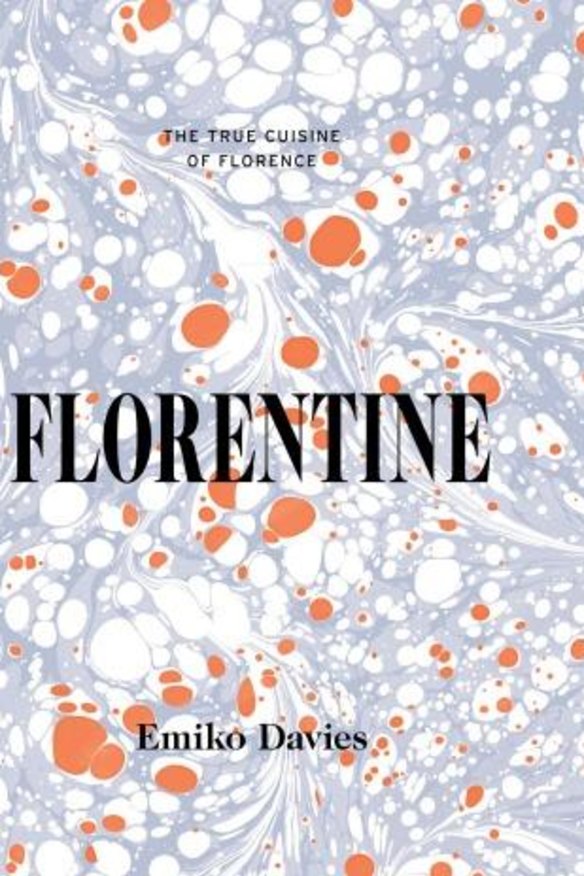From Canberra to Italy - the making of Emiko Davies' Florentine cookbook

I think I was about eight or nine years old when I made an announcement to my parents that I was going to publish my first "book", an illustrated story about a family of frogs that I had drawn, written and stapled together while they were out at dinner one night. They were quick to give me a crushing reality check by dissuading me to send my crumpled papers in to Penguin, explaining that books aren't made that way, but my love of books eventually led me to Florence in my mid-20s to study book restoration, where I stayed for years, fell in love, got married and started a food blog.
Fast forward eight years and I had moved with my Tuscan husband and one-year-old baby back to Canberra. Then one day, sitting in the kitchen, I opened up my laptop to find an email from a publisher (Hardie Grant to be exact) asking if I would like to write a cookbook. I ran through the house, jumped around, I think I cried, just a little, then finally sat back down to respond to the email with an enthusiastic "yes". It seems that ever since that frog story, I never did get the idea of writing a book completely out of my head.
I knew immediately that the subject matter had to be about Florence, the place where it all started – my blog, my love of regional Italian food, its history and traditions and also where I learned to eat and cook like an Italian. Florence was not only an obvious choice for me but an attractive one because it's a well-visited, unique and beautiful city, whose rustic and homely food is as fun to cook as it is delicious – and its cuisine has, incredibly, barely ever been written about in English.

Now I had a chance to tell people about this wonderful cuisine, how its incredible art history is even woven into the food, not just the stones of the buildings and sculptures; what panzanella salad looked like during the painter Bronzino's time (he no doubt loved it as he wrote a poem about it); which dish supposedly was a favourite of Leonardo da Vinci; how the Florentines lay claim to crepes, onion soup and the invention of gelato – basically how each and every dish is connected specifically to this city. It's not just Italian cuisine, it's not even simply Tuscan cuisine. It's Florentine cuisine.
The bulk of the cookbook writing process was, admittedly, a lot of eating. I had spent seven years living in Florence, where, although I didn't know it at the time, I was gathering information and practising the dishes for this book every day in the form of eating plenty of Florentine food, getting accustomed to eating pastries and espresso for breakfast, learning to mop up food with unsalted bread, regularly visiting wine bars (my husband is a sommelier, so you could say drinking wine was part of the job) and the markets (where old ladies like to exchange recipes), strolling the streets for the evening passeggiata, gelato in hand, and developing an affection for offal.
Compiling a list of recipes that I both loved and that represented Florence was easy, thanks to all this "research", but then came the recipe testing part. Out of our Canberra kitchen, I had to re-create Florence's favourite dishes: ribollita (a thick and hearty vegetable and bread soup which has barely changed since Pellegrino Artusi included the recipe in his 1891 cookbook), chicken liver crostini, bistecca alla fiorentina (a huge, lean T-bone, three fingers thick, grilled extremely rare), even the pastries that are so loved in Florence, from cornetti to sfogliatine (puff pastry pockets filled with custard) to budini di riso (rice pudding tarts), and, my favourite, schiacciata all'uva, a focaccia-like bread studded with oozing red wine grapes to mark the grape harvest season every autumn.
As much as I wanted each recipe to be authentic, I knew that some ingredients would just be different and perhaps difficult to find – artichokes, for example, and not globe artichokes but the slender, pointed purple artichokes of Tuscany; wild strawberries (also known as alpine strawberries) which I ended up ordering online and growing in pots in the courtyard; lardo – not lard, but salty, silky, thinly sliced melt-in-your-mouth cured pork back fat; European-style unsalted butter, which is cultured, creamier, and paler than regular Australian butter. Even the fresh sheep's milk ricotta is different. But this was ok, because it is, after all, a cookbook written not for the Florentines, but for people outside of Florence.
On the other hand, Canberra supplied me with great produce to work with and my trips to the Southside Farmers and EPIC markets were always rewarded with wonderful local ingredients like cavolo nero (thank goodness for frosty mornings here! Cavolo nero always tastes better after the frost), floury potatoes perfect for gnocchi, pungent, fresh black truffles for truffled panini and apples and pears for apple cake and pear and pecorino crostini. Meanwhile, thanks to the garden there were always plenty of herbs (the sage is still going strong) and tomatoes, and the plum sorbet, the last recipe in the book, was inspired completely by the neighbour's prolific plum tree which hangs almost entirely on our side of the fence.
I even managed to find almost all of the offal that is commonplace in Florence, from pork liver and lacy caul fat to chicken liver and tripe, thanks to Unique Meats at the Fyshwick Markets and Griffith Butchery.
Then, to ease my fears of having recipes not turning out correctly with sometimes slightly adapted ingredients, I enlisted the help of an army of recipe testers across the globe who adventurously volunteered to attempt my recipes and create a taste of Florence in their kitchens in the US, India, Japan, New Zealand and Canberra (of course). These wonderful home cooks proved that the problem with the sourcing of the right ingredients and re-creating authentic Florentine food was barely an issue at all.
A year ago I returned to live in Florence, with my homesick husband and our now three-year-old daughter, and we still cook regularly many of the dishes that made their way into the cookbook. But every time we stop at the markets for fresh out of the fryer bomboloncini, I think of the recipe-testing in Canberra when I had cooked too many bomboloncini to know what to do with and had to hand them out to friends just to get them out of the kitchen. And when I spot the little oval containers of wild spring strawberries perfuming the market stalls in Florence or the wide crates full of cheap, dark, late summer plums, I am instantly reminded of the courtyard at my family home in Canberra where the mail order Alpine strawberries are still growing profusely and of collecting plums off the neighbour's tree, which has since been cut right back (I think they must have noticed). I brought Florence into my Canberra kitchen, but I realise, there's now a bit of Canberra in my Florentine kitchen too.
Florentine is published by Hardie Grant. $49.95. Emiko Davies will launch Florentine in Canberra at the Essential Ingredient in Kingston. Saturday, March 12, from 4pm. Bookings on 6295 7148.
There will also be a Florentine cooking and photography workshop with Luisa Brimble and Emiko Davies at Glenmore House outside Sydney. Saturday, March 19. $250 includes the workshop, seasonal sit-down lunch and a copy of the book. 9am-4.30pm. Book at emikodavies.com/events
The best recipes from Australia's leading chefs straight to your inbox.
Sign up